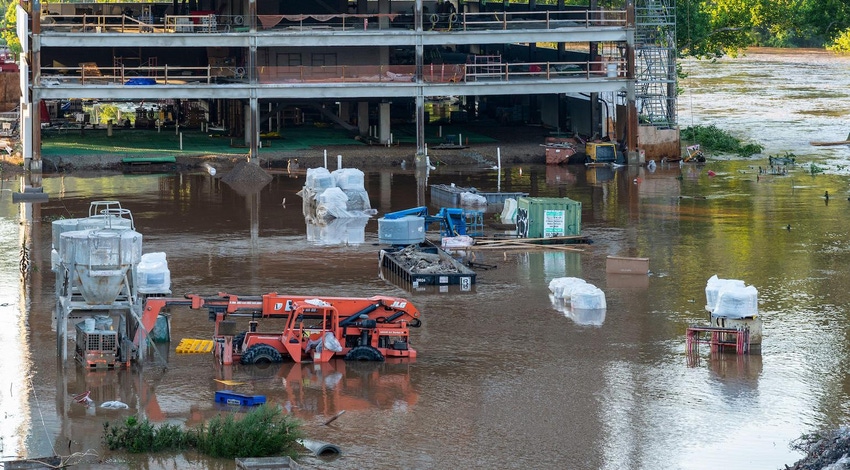As your construction business does recovery and repair work after the storm, make sure you know what to watch out for and how to keep your team safe.

Recently, much of Florida—and other coastal states—felt the wrath of Hurricane Ian. In some counties, homes and businesses were damaged or destroyed. Flooding continues in many areas, and power outages have been widespread. More than 100 people in Florida lost their lives, but that count is far from final. It has been a challenging and devastating time for so many.
If your business was affected, you have likely already contacted your insurance agent. But you also probably feel like there are a million other things you need to do. As you begin to pick up the pieces after the storm, make sure you know how to protect your employees.
Cleaning up after a hurricane
By definition, a hurricane is a type of tropical cyclone with sustained winds of 74 mph or more. However, some hurricanes, such as Ian, have higher wind speeds—even exceeding 155 mph. In addition to leveling structures, the wind and water associated with these storms can down power lines, wash away docks, boardwalks and buildings and cause flooding along streets and in buildings.
If you and your workers are cleaning up after a severe storm, follow these OSHA guidelines. Check for hazards before you begin work, and ensure that everyone wears the appropriate personal protective gear.
Watch out for these seven hazards in particular:
Downed power lines: It may be hard to see power lines if they are in the water or under debris, so use caution. Coming in contact with downed power lines can result in severe burns or electrocution. If you see any power lines, assume that they are live. Mark a danger zone around them and stay at least 10 feet away. Ensure that only well-trained and well-equipped workers try to repair these lines.
Dangerous floodwaters: The water in flooded areas can be contaminated with toxins from waste sites, as well as bacteria and mold. Also, remember that alligators and snakes can lurk in this water in some areas of the country. Workers should wear waterproof boots and rubber or latex gloves. Goggles and chemical-resistant clothing are also recommended. Be sure to use N-95 NIOSH-approved respirators if mold is present. If the area is enclosed, try to ventilate with fresh air. Before entering the space, ensure that all workers are current with their tetanus shots (vaccinated within the last 10 years).
Tree limbs and debris: Hurricanes can wreak havoc on trees. When your workers are tending to downed trees or cleaning up debris, make sure they use caution. They can be injured by chainsaws and chippers or struck by falling limbs. They can also be electrocuted if the tree limbs come in contact with power lines. Before starting cleanup, see if the utility company can de-energize the area. Mark the danger zone, and remind all workers to stay alert. They must wear hard hats, work gloves and boots and protective face and eye protection. Make sure they keep their distance from chippers and never reach inside one.
Fall risks: During cleanup, workers may be on ladders, roofs and aerial lifts, and surfaces can be slippery or uneven. Ensure workers wear safety harnesses when they are on lifts and follow basic ladder safety at all times. Falls can lead to injuries and fatalities.
Portable generators: Many homes and businesses rely on generators, but they can be hazardous. If they are improperly fueled, they can start fires. They can also cause shock, electrocution and carbon monoxide poisoning. Never operate generators in an enclosed space, such as a home, office or garage. Ensure that they are shut off before refueling and that all electrical cords are in good condition.
Standard construction risks: Workers can encounter many dangers when repairing damaged structures. For instance, they may be exposed to asbestos when tearing down a building. They can also be trapped in confined spaces and be injured when lifting construction materials. In addition, they can suffer injuries from trenching and excavation accidents. Therefore, ensure they wear the appropriate personal protective gear and do not enter confined spaces without the applicable permit. Furthermore, ensure that everyone is trained in trenching safety and proper lifting skills.
Work-zone hazards: In the aftermath of a storm, working conditions can be dark and wet. It is easy for workers to be struck by moving vehicles. So be certain that everyone wears high-visibility clothing and uses proper traffic lighting and controls, such as barriers and cones.
Preparing for next time
The Atlantic hurricane season lasts from June until November, while the eastern Pacific season starts a little earlier, in mid-May. This means that you and your workers have several months during which you must be prepared for the worst.
Before the next big storm hits, make sure you have a plan in place that includes emergency processes, evacuation procedures, communications with employees and customers and what conditions warrant the plan to be activated. If you were underprepared for Hurricane Ian, review OSHA’s Hurricane Preparedness and Response guidelines so you are ready for the next massive storm.
Your obligation to your workers
OSHA mandates that you provide your employees with a safe workplace. So, whether regrouping after a severe weather event or planning for one, you must know how to protect your workers. If you are unsure how to accomplish that, OSHA provides training that you can utilize for yourself, your supervisors and your employees.
If you have questions about OSHA requirements or how to implement them, do not hesitate to consult legal counsel. An experienced OSHA attorney can help you understand your obligations and help you safeguard your company and your workers.
The information contained in this article is for general educational information only. This information does not constitute legal advice, is not intended to constitute legal advice, nor should it be relied upon as legal advice for your specific factual pattern or situation.
Trent Cotney, partner and construction team co-leader at Adams and Reese LLP, serves as an advocate for the roofing industry and general counsel of the National Roofing Contractors Association and several other industry associations. For more information, contact the author at [email protected] or at 813.227.5501.
About the Author(s)
You May Also Like




